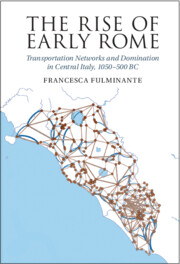Book contents
- The Rise of Early Rome
- The Rise of Early Rome
- Copyright page
- Dedication
- Contents
- Figures
- Tables
- Acknowledgements
- Introduction
- Chapter 1 The Ancient City
- Chapter 2 Transportation Infrastructures
- Chapter 3 Data and Methodology
- Chapter 4 Network Analysis Centrality Indexes
- Chapter 5 Network Analysis Efficiency Indexes
- Chapter 6 Multi-scale Analysis Based on Least-Cost Paths
- Chapter 7 Modelling
- Conclusions
- Data, Mathematical Explanations and Calculations
- Notes
- Bibliography
- Index
Chapter 5 - Network Analysis Efficiency Indexes
Published online by Cambridge University Press: 17 August 2023
- The Rise of Early Rome
- The Rise of Early Rome
- Copyright page
- Dedication
- Contents
- Figures
- Tables
- Acknowledgements
- Introduction
- Chapter 1 The Ancient City
- Chapter 2 Transportation Infrastructures
- Chapter 3 Data and Methodology
- Chapter 4 Network Analysis Centrality Indexes
- Chapter 5 Network Analysis Efficiency Indexes
- Chapter 6 Multi-scale Analysis Based on Least-Cost Paths
- Chapter 7 Modelling
- Conclusions
- Data, Mathematical Explanations and Calculations
- Notes
- Bibliography
- Index
Summary
As we have seen in Section 1.2 of Chapter 1, between the Final Bronze Age and the beginning of the Early Iron Age, southern Etruria and Latium vetus underwent important processes of centralisation and nucleation of the settlement system that led to the formation of large proto-urban centres. These eventually evolved into cities during the end of the Early Iron Age, the Orientalising Age and the Archaic Period. A graph representing the trend of median settlement size in southern Etruria and in Latium vetus through time, shows how the two regions had a similar beginning and parallel development with different final outcomes (Fig. 5.1). Is it possible to explain the reason for this final result? Were the initial situations after all so similar? In Chapter 4, by analysing centrality measures calculated on the fluvial and terrestrial networks of the two regions we emphasised some similarities and differences. In this chapter we focus further on the infra-structural systems of the two regions (fluvial and terrestrial communication routes) and we analyse and compare their characteristics and functionality.
- Type
- Chapter
- Information
- The Rise of Early RomeTransportation Networks and Domination in Central Italy, 1050–500 BC, pp. 87 - 93Publisher: Cambridge University PressPrint publication year: 2023



